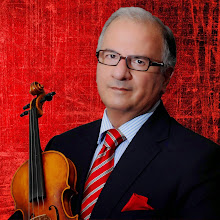It was strange…after forty years of continuous concert going, I was thinking in the interval, how this habit of mine to sit in the first row started when it’s not an interesting location for the overall sound heard, nor the best place for visual purposes…the best can be viewed is the strings section and only the first rows! Then I went back, with the wings of imagination, to my home town 40 years back, when viewing Henryk Szeryng, for instance, playing Beethoven with the Tehran Symphony Orchestra from the closest distance possible was a once-in-a-life-time chance, especially for a young 14-year boy.
Anyway, Maestro Tovey opened the concert with “Earth Songs” by Professor Stephen Chatman, Head, Composition Division at The University of British Columbia. This piece was commissioned by the UBC in honour of its centenary four years ago (2007). Vancouver Bach Choir joined the VSO in performance of this work. A beautiful work...made me buy the CD at the interval!
The all-classic part of the evening started after that with the beautiful second concerto of Beethoven, totally a Mozartian type. Opus number 19 shows it all. The 39-year-old pianist from Vienna
First movement begins with a long introduction by tutti in the tonic key of B-flat major. Solo enters after a few chromatic passages and a full classic conversation between the solo and tutti continues the movement.
Adagio is one of the charming Beethoven’s movements in the subdominant key of E-flat major.
And finally comes the finale, again a totally classic 7-part rondo in a 6/8 rhythm. A Beethoven typical musical joke can be heard right before the last appearance of the rondo theme when solo moves to a G major key by mistake but tutti guides the solo to the correct tonic key!
After the interval, the glamorous Symphony No. 40 of Mozart was performed. The amazing sound of the orchestra of our town shows much better in symphonies far from natural mistakes of the soloists that distract the average audience. And Maestro Tovey, as I told him once in the West Vancouver Library, is as wonderful as his guru, the late Leonard Bernstein I loved.
The first theme is just charming, although a bit dark and sad. It starts in the tonic key of G major with the accompaniment of the lower strings. This technique was widely used later by early romantics. An example is the beginning of Mendelssohn’s first violin concerto.
Slow movement moves to E-flat, the submediant major of the main key.
The minuet is a true Mozartian-classic ¾ dance including a happier trio. To me, it was performed too fast for an eighteenth century court dance...should be more elegant. Probably Maestro Tovey wanted to finish the fastest concert (under two hours) even faster and go home!
Finale, allegro assai in the tonic G minor is a very rhythmic live movement, a happy ending for a great symphony.
This time, nothing exciting happened, no baton flew in the air, no D string of the second violins broke…nothing!


